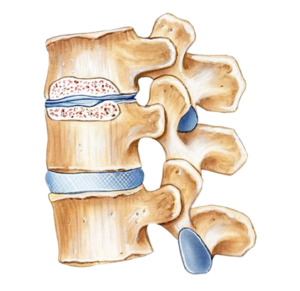What is Spinal Stenosis?
Stenosis is a Greek word that means “narrowing or constricting space.” That being said, spinal stenosis is simply the narrowing of the spinal canal that houses the spinal cord and nerve roots of the spine. There are many types of spinal stenosis, including central canal stenosis, lumbar spinal stenosis, and cervical spinal stenosis.
Spinal stenosis also referred to as canal stenosis or spinal canal stenosis, generally occurs in two sections of the spine: cervical and lumbar. The cervical spine is located in the neck, and the lumbar spine is located in the lower back. The reason why these two sections are diagnosed with spinal stenosis more than the thoracic spine (middle of the back) is that the cervical and lumbar spine serves to bend, move, and provide flexibility. The thoracic spine’s main function is to provide support and stabilization. When the spinal canal narrows, the nerves in the spinal cord are more likely to be compressed if there is continual bending and moving of the vertebrae. For this reason, spinal stenosis is more evident and symptomatic in the cervical and lumbar sections of the spine.
While the definition of spinal stenosis is relatively simple to understand, the cause of spinal stenosis is slightly more complex.

Causes of Spinal Stenosis
Determining the cause of spinal stenosis can be complicated because, while spinal stenosis is the narrowing of the spinal canal, there is usually an underlying spine condition that is causing the spinal canal to narrow. For example, a bulging or herniated disc would cause the spinal canal to narrow in a particular place because the bulging disc has moved out of its normal zone in the spine. In this case, the patient would have spinal stenosis caused by a bulging disc.
However, there are several instances when spinal stenosis is caused by nothing more than the natural aging process. As we age, the ligaments in our spine can become thicker and compressed. Bone spurs may grow on the vertebrae of the spine. Discs in between vertebrae may deteriorate and misalign along the spine. All of these natural aging occurrences can cause the spinal canal to narrow and a nerve root or the spinal cord to be impacted.
Some of the most common spine conditions that cause spinal stenosis are as follows:
If you have been diagnosed with any of these spine conditions, you might want to consult your physician about the possibility of your condition causing spinal stenosis.
Preventing Spinal Stenosis
Since the main cause of spinal stenosis is the general aging process, standard healthy life changes can be an effective way to help prevent spinal stenosis. For example, consider implementing the following habits into your daily life:
- Regular exercise
- Healthy diet
- Comfortable sleep
- Good posture
A regular exercise program, like swimming, yoga, and Pilates, helps develop core strength and allows you to maintain strength and flexibility in your spine. That, matched with a healthy diet, ideal weight, and proper nourishment, is the key to maintaining a healthy spine. In addition, sleeping on a bed that properly supports your spine, as well as practicing good posture and lifting mechanics, can help you avoid and reduce spine-related injuries and conditions.
Safe practices at home and the workplace can help you avoid injuries of all kinds. When it comes to injuries to your back, there are certain activities you should try and avoid, or take precautions against.
If you think you show signs of the condition, or would like to confirm your suspicions that you may have spinal stenosis, we recommend calling us today for a consultation.
If you would like to find out more about your condition and how we can help you, please feel free to contact us. Our team will provide you with a no-cost MRI review* to help determine if you are a candidate for our minimally invasive, outpatient spine surgeries.